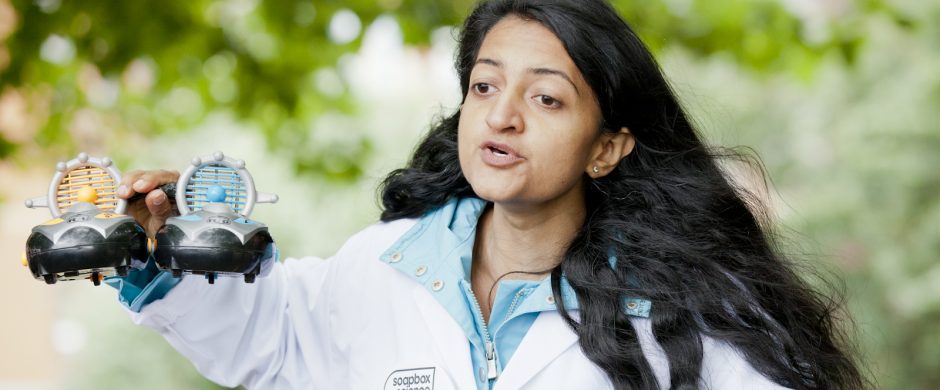 Dr Roslin Adamson (@AdamsonRos), will be taking part in Soapbox Science Oxford on 28th July 2018 with the talk: “One mutant protein, two devastating diseases. Can we cure them both?
Dr Roslin Adamson (@AdamsonRos), will be taking part in Soapbox Science Oxford on 28th July 2018 with the talk: “One mutant protein, two devastating diseases. Can we cure them both?

Diamond Light Source, the synchrotron (particle accelerator) in Didcot, where we shoot x-ray beams at our protein crystals
SS: What, or who, inspired you to get a career in science?
RA:My story is a bit unusual. I first did a degree in fine art, but then ended up teaching English in Japan for 8 years. While I was in Japan I became involved in bodybuilding and began reading as much as I could about nutrition, protein synthesis, vitamins, supplements and their effects on the body. However, much of the research was very difficult for me to understand, so I decided I would go back to university to study science. Doing a master’s degree and a PhD just followed naturally. I am now in an area that I really enjoy – protein structure/function, although I no longer lift weights unfortunately, due to an injury.
SS: What is the most fascinating aspect of your research/work?
RA:I think the most interesting part about my work is the fact that we can “see” molecules on almost an atomic scale! This is mind-boggling to me, aside from how incredibly intricate and perfectly organised the cell and the organism are. The way that the protein machinery in the cell dances this delicate balance between function and dysfunction, and how each protein or protein complex knows what it has to do, and the kind of cellular effects that can occur according to diet and other environmental factors, as well as genetics, is thrilling and almost mystical in its complexity. I also love the clever ways that working with proteins has been approached by past scientists – the methods and techniques that we take for granted today were unheard of and unthought of not so long ago. The advances in biological and medical sciences are incredible, and yet there is still so much to learn …

Some pictures of protein crystals
SS: What attracted you to Soapbox Science in the first place?
RA: I am both a scientist and an artist, so I was keen last year to participate in the Art/Science Soapbox Science, where I was teamed up with an artist who interpreted my science work. I enjoyed it so much I decided to participate again this year. SS is an excellent platform for me to share my enthusiasm for science and what we can learn from it with the wider public, and also to show that actually, there are many extremely competent women in science doing amazing things, for which they are frequently not given credit. I fear there is often a sense in people who don’t know about science that scientists are cold and calculating, without ethics, and that what we do is dangerous somehow. Perhaps there have been a tiny minority of cases that could give this impression, but the vast majority of biological scientists I know care very deeply that their work will help people who have the dreaded diseases they are working on, or that they can help the world to be a better place in some way. I think it’s also really important that events like this give children the opportunity to learn about science and to see that scientists come in all shapes and forms. At the SGC, where I work, we do regular school visits to do science with young kids, and they are absolutely fascinated, and super engaged. This is incredibly rewarding.

Skeleton of someone with fibrodysplasia ossificans progressiva (FOP), one disease I work on.
SS: If you could change one thing about the scientific culture right now, what would it be?
RA: Gosh. Tough one. There’s the funding culture, where it seems the big-name labs with fashionable topics get all the money. Applying for grant funding is soul-destroying, as there really just isn’t enough money to go round, and publication records often trump originality. This obviously has a knock-on effect on people’s livelihoods and jobs. The culture of short fixed-term post-doc contracts with specific and time-limited funding means you never really have any job security, and often, a project just ends when you leave, which seems a waste of resources.

Brain scan of diffuse intrinsic pontine glioma (DIPG) the other disease I work on.
SS: What would be your top recommendation to a female PhD student considering pursuing a career in academia?
RA: I would say build up your mental and emotional resilience (which certainly a PhD will do for you!). It is not an easy ride, but then, things worth doing aren’t always easy. Choose a lab/project where you will gain both new skills and also be able to publish reasonably regularly. Start applying for fellowships or other grants as soon as you have enough publications, as later on your ability to get money from funding agencies will be a factor in hiring. Academia has an enormous number of advantages in terms of the relative freedom we have in our studies, but funding really is a crunch line.
